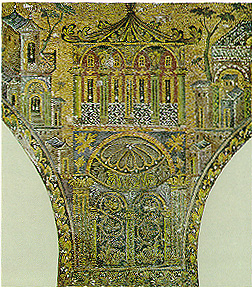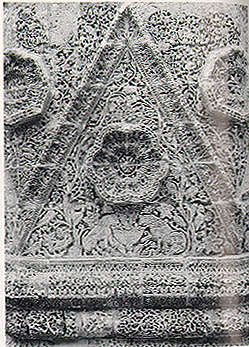
Scanned from Gardneršs Art Through the Ages, Tenth Edition

allahallah Of all the mosaics in the Great Mosque, there are no zoomorphic forms, human or animal, either in the pictorial or ornamental spaces. This is evidence, even at the very beginning of Islamic Art, of the restriction in traditional Islam against the representation of figures of any kind in sacred places. The world shown in the mosaic, which is a mirage-like in a field of gold, and is devoid of any figures, may be an image of paradise. Places of Paradise, such as gardens, flowing streams, groves of trees, and "lofty chambers," are described in the Qu'ran.
Arabesque above portal of mosque at Cordoba, Spain, eighth to tenth centuries
Scanned from Gardneršs Art Through the Ages, Tenth Edition
allahallahThe mosaics of the domes and ribs are the last major mosaic decor of Muslim architecture. They display the progressive reduction of illusionistic forms that began in the Great Mosque at Damascus into abstract shapes in flat, textile-like patterns.
allahallahOn the exterior of the building, the architectural theme is repeated along with the decorative theme. The intersection of the three main arches above the blind arcade are reproduced from the interior intersecting arches. Within the arches, panels of alternating geometrical and vestigally floral shapes appear. The maze, meander, fret and swastika, checkerboard and star appear, which are bounded by panels of tendrils, rosettes, palm leaves, and rosettes. This intricate system of decoration that identifies the art of Islam everywhere is called the arabesque. The arabesque expressed "the Islamic delight in the revelation and exploration of pure form and the contemplation of it as the unity in the variety of the cosmos" while "renouncing the material world of shadow-casting objects" (Gardner).
Portion of stone frieze, palace at Mshatta, Jordan, c. 743. Staatliche Museen, Berlin. 
Scanned from Gardneršs Art Through the Ages, Tenth Edition
allahallahThe gate and facade of this unfinished palace in the Jordanian desert are decorated by a wide, richly carved stone frieze. The major characteristics of Early Islamic decoration current in the last years of Umayyad power are illustrated in the design, arrangement, and relation to its carrier. A long band, almost fifteen feet high, is decorated with a series of triangles of the same size framed by an elaborately carved molding. A large rosette projecting from a field of densely covered curvilinear, vegetal designs is contained in every triangle. Even animal figures appear in some of them. Although the sources of the design can be seen as taken from Late Classical, Early Byzantine, and Sasanian Persian, their combination and arrangement are typically Islamic.
allahallahMost of the design elements of Islamic ornament are based on plant motifs, which are sometimes intermingled with symbolic geometric figures and with figural shapes. These natural forms often become so stylized that the actual elements are lost in the decoration of the leaves and stalks. The arabesques cover the entire surface of the object or building. The tendency to cover the entire surface is called horror vacui (literally "fear of empty space") and is similar to tendencies in barbarian art. As Tansey and Kleiner state, "The repetitive patterns serve to suggest divine infinity and indefinability" (Gardner). Most characteristic of these designs is the independence of each from its carrier. Neither its size nor its forms are dictated by anything but the design itself.
allahallahFloor Mosaic
allahallahStone carving, as we have seen in the stone frieze of the Palace at Mshatta, is only one of several techniques used for architectural decoration. Floor mosaics and wall paintings continued a long tradition from the cultures of the Mediterranean. In later periods, colored tile became increasingly important. One prime example of a floor mosaic is found in the Palace at Khirbat al-Mafjar near Jericho, mid-eighth century:
Scanned from Gardneršs Art Through the Ages, Tenth Edition
allahallahIn this floor mosaic, medallions with intricate abstract designs are set into square and rectangular fields with a rich variety of floral and geometric patterns. Click here to move on.